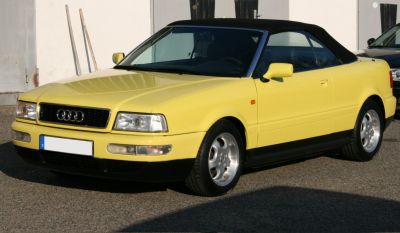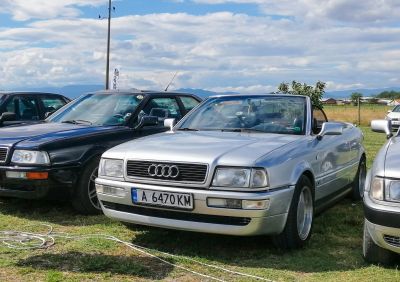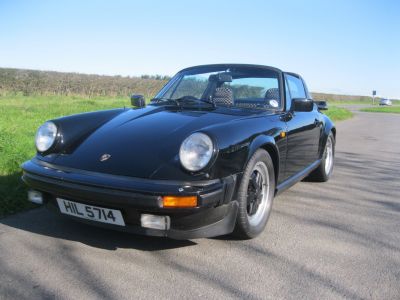 1985 BMW 3 Series Convertible (E30) Dimensions, Size & Specs
1985 BMW 3 Series Convertible (E30) Dimensions, Size & SpecsMeasurements of the 1985 BMW 3 Series Convertible, engineered for optimal performance and comfort
| Dimensions | |
|---|---|
| Length: | 4325 mm170.3 in14.2 ft |
| Width: | 1645 mm64.8 in5.4 ft |
| Height: | 1370 mm53.9 in4.5 ft |
| Ground Clearance: | 125 mm4.9 in0.4 ft |
| Trunk Capacity: | 311-312 liter11.0-11.0 cu ft |
| Weight Specifications | |
| Curb Weight: | 1280-1310 kg2822-2888 lbs |
| Maximal permitted Weight: | 1680-1710 kg3704-3770 lbs |
| Tire Specifications | |
| Rims Sizes: |
|
| Tire Sizes: |
|
The BMW 3 Series Convertible (E30) was produced from 1985 to 1986, marking a distinct version of BMW's iconic compact executive car tailored for open-air driving enthusiasts. With a length ranging from 4321 to 4325 mm (170.1 to 170.3 inches), width between 1641 and 1645 mm (64.6 to 64.8 inches), and height around 1369 to 1370 mm (53.9 to 54 inches), the E30 convertible presents a sleek yet balanced silhouette typical of 1980s automotive design. This cabriolet maintains a low ride height of 125 mm (4.9 inches), contributing to its sporty road presence and handling dynamics.
Weighing between 1280 and 1310 kg (2822 to 2888 lbs) when empty, the E30 cabriolet stays relatively light, ensuring responsive driving performance. The maximum permissible weight ranges from 1680 to 1710 kg (3704 to 3770 lbs), supporting a practical load capacity while preserving agility. The convertible's luggage space measures 311 to 312 liters (11 to 11 cubic feet), offering reasonable trunk volume for a car of this body style.
Standard wheel sizes for the E30 convertible include 14 or 15-inch rims, paired with tire options such as 195/65 R14, 195/65 R15, and their higher speed-rated variants (HR and VR), allowing for a balance between comfort and grip on the road. This generation's dimensions and lightweight construction epitomize the BMW 3 Series approach to blending sporty driving with everyday usability. The E30 convertible remains a celebrated classic among automotive enthusiasts for its design purity and engaging driving experience.
Discover the standout features that make the 1985 BMW 3 Series Convertible a leader in its class
Have a question? Please check our knowledgebase first.
The BMW 3 Series Convertible (E30) from 1985 to 1986 features a length ranging between 4321 mm and 4325 mm (approximately 170.1 to 170.3 inches). Its width spans from 1641 mm to 1645 mm (around 64.6 to 64.8 inches), while its height varies slightly between 1369 mm and 1370 mm (about 53.9 to 54.0 inches). These dimensions give the E30 Cabriolet a compact yet sporty stance typical for luxury convertibles of its era.
The curb weight of the BMW 3 Series Convertible (E30) ranges from 1280 kg to 1310 kg (2822 to 2888 lbs). This weight reflects the build quality and materials used in mid-1980s convertibles, balancing structural rigidity for safety and performance with an eye on maintaining agility. Compared to other convertibles of the time, this weight is fairly typical, allowing the car to deliver spirited driving dynamics without feeling too heavy or unwieldy.
The luggage capacity for the BMW 3 Series Convertible (E30) lies between 311 and 312 liters (about 11.0 cubic feet). For a convertible, this is a reasonable amount of storage, accommodating daily essentials and modest luggage. However, as with many convertibles, space behind the seats and the area taken up by the retractable roof mechanism slightly limit storage compared to a coupe or sedan variant. Still, it remains practical for weekend trips or light errands.
The BMW 3 Series Convertible (E30) has a ride height or ground clearance of 125 mm (approximately 4.9 inches). This relatively low clearance emphasizes handling performance and stability, typical of sporty convertibles. While this enhances cornering and road feel on smooth tarmac, it means caution is needed when driving over speed bumps, potholes, or uneven terrain to avoid undercarriage damage. It's best suited for well-maintained urban or suburban roads.
The BMW E30 Convertible was equipped with either 14-inch or 15-inch rims. The tire dimensions matched these rim sizes and included 195/65 R14, 195/65 HR14, and 195/65 R15 or 195/65 VR15 configurations. These tire sizes contributed to balanced handling, ride comfort, and road grip, supporting the car's reputation for agile and responsive driving dynamics during its production years.
Yes, the BMW 3 Series Convertible (E30) fits comfortably into a standard home garage. With an exterior length of about 4.32 meters (approximately 14.2 feet), a width just over 1.64 meters (around 5.4 feet), and height close to 1.37 meters (about 4.5 feet), it is well within the typical clearance and space constraints of most residential garages. Owners should, however, consider additional space for opening doors and storing the convertible top if needed.
The E30 Convertible marked a refinement over its predecessor, the E21 3 Series range. While both models occupy the compact executive car segment, the E30 Convertible is slightly larger with improved dimensions: Length increased to around 4321-4325 mm from the E21's generally shorter profile, which improved interior space and luggage capacity. The E30 also had a more modern design, enhanced structural integrity, and better handling dynamics compared to the E21, making it a significant progression in BMW’s convertible lineup.
When compared to similar mid-1980s luxury convertibles, such as the Mercedes-Benz SL (R107) or the Audi Cabriolet, the BMW E30 Convertible was more compact and slightly lighter, enhancing agility and driver engagement. With a length of about 4.32 meters and curb weight around 1280 to 1310 kg, it was generally more nimble. While Mercedes SL models were larger and more comfort-oriented, and the Audi Cabriolet slightly more utilitarian, the E30 offered an excellent balance of sporty handling and everyday usability within its size class.
The width of the BMW 3 Series Convertible (E30) ranges from 1641 mm to 1645 mm (approximately 64.6 to 64.8 inches). This moderate width provides a cozy yet comfortable cabin space typical of compact convertibles from this era. It allows for two occupants to enjoy adequate shoulder room without feeling cramped, while also contributing to the car’s nimble handling characteristics. The relatively narrow width compared to more modern vehicles keeps it well-suited for city driving and narrower roads.
With a height varying slightly between 1369 mm and 1370 mm (approximately 53.9 to 54.0 inches), the BMW 3 Series Convertible (E30) maintains a low-slung profile that enhances both its sporty aesthetic and aerodynamic efficiency. This relatively low height contributes to a lower center of gravity, improving handling and stability especially during cornering. It also creates a sleek silhouette with classic convertible proportions, appealing to enthusiasts seeking both performance and style.
Discover similar sized cars.

| Production: | 1995-2001 |
|---|---|
| Model Year: | 1997 |
| Length: | 4366 mm171.9 in |
| Width: | 1716 mm67.6 in |
| Height: | 1379 mm54.3 in |

| Production: | 1991-1997 |
|---|---|
| Model Year: | 1992 |
| Length: | 4366 mm171.9 in |
| Width: | 1716 mm67.6 in |
| Height: | 1379 mm54.3 in |

| Production: | 1973-1980 |
|---|---|
| Model Year: | 1974 |
| Length: | 4291 mm168.9 in |
| Width: | 1610-1652 mm63.4-65.0 in |
| Height: | 1320-1340 mm52.0-52.8 in |
